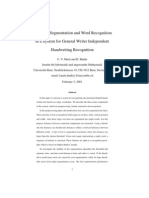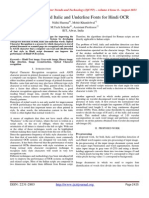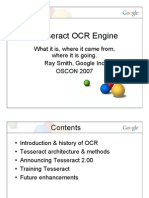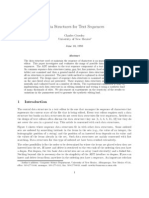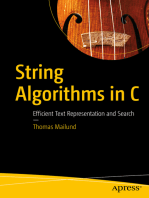Overview of Tesseract OCR Engine
Overview of Tesseract OCR Engine
Uploaded by
rrs_1988Copyright:
Available Formats
Overview of Tesseract OCR Engine
Overview of Tesseract OCR Engine
Uploaded by
rrs_1988Original Description:
Copyright
Available Formats
Share this document
Did you find this document useful?
Is this content inappropriate?
Copyright:
Available Formats
Overview of Tesseract OCR Engine
Overview of Tesseract OCR Engine
Uploaded by
rrs_1988Copyright:
Available Formats
An Overview of the Tesseract OCR Engine
Ray Smith
Google Inc.
theraysmith@gmail.com
Abstract
The Tesseract OCR engine, as was the HP Research
Prototype in the UNLV Fourth Annual Test of OCR
Accuracy[1], is described in a comprehensive
overview. Emphasis is placed on aspects that are novel
or at least unusual in an OCR engine, including in
particular the line finding, features/classification
methods, and the adaptive classifier.
1. Introduction Motivation and History
Tesseract is an open-source OCR engine that was
developed at HP between 1984 and 1994. Like a super-
nova, it appeared from nowhere for the 1995 UNLV
Annual Test of OCR Accuracy [1], shone brightly with
its results, and then vanished back under the same
cloak of secrecy under which it had been developed.
Now for the first time, details of the architecture and
algorithms can be revealed.
Tesseract began as a PhD research project [2] in HP
Labs, Bristol, and gained momentum as a possible
software and/or hardware add-on for HPs line of
flatbed scanners. Motivation was provided by the fact
that the commercial OCR engines of the day were in
their infancy, and failed miserably on anything but the
best quality print.
After a joint project between HP Labs Bristol, and
HPs scanner division in Colorado, Tesseract had a
significant lead in accuracy over the commercial
engines, but did not become a product. The next stage
of its development was back in HP Labs Bristol as an
investigation of OCR for compression. Work
concentrated more on improving rejection efficiency
than on base-level accuracy. At the end of this project,
at the end of 1994, development ceased entirely. The
engine was sent to UNLV for the 1995 Annual Test of
OCR Accuracy[1], where it proved its worth against
the commercial engines of the time. In late 2005, HP
released Tesseract for open source. It is now available
at http://code.google.com/p/tesseract-ocr.
2. Architecture
Since HP had independently-developed page layout
analysis technology that was used in products, (and
therefore not released for open-source) Tesseract never
needed its own page layout analysis. Tesseract
therefore assumes that its input is a binary image with
optional polygonal text regions defined.
Processing follows a traditional step-by-step
pipeline, but some of the stages were unusual in their
day, and possibly remain so even now. The first step is
a connected component analysis in which outlines of
the components are stored. This was a computationally
expensive design decision at the time, but had a
significant advantage: by inspection of the nesting of
outlines, and the number of child and grandchild
outlines, it is simple to detect inverse text and
recognize it as easily as black-on-white text. Tesseract
was probably the first OCR engine able to handle
white-on-black text so trivially. At this stage, outlines
are gathered together, purely by nesting, into Blobs.
Blobs are organized into text lines, and the lines and
regions are analyzed for fixed pitch or proportional
text. Text lines are broken into words differently
according to the kind of character spacing. Fixed pitch
text is chopped immediately by character cells.
Proportional text is broken into words using definite
spaces and fuzzy spaces.
Recognition then proceeds as a two-pass process. In
the first pass, an attempt is made to recognize each
word in turn. Each word that is satisfactory is passed to
an adaptive classifier as training data. The adaptive
classifier then gets a chance to more accurately
recognize text lower down the page.
Since the adaptive classifier may have learned
something useful too late to make a contribution near
the top of the page, a second pass is run over the page,
in which words that were not recognized well enough
are recognized again.
A final phase resolves fuzzy spaces, and checks
alternative hypotheses for the x-height to locate small-
cap text.
3. Line and Word Finding
3.1. Line Finding
The line finding algorithm is one of the few parts of
Tesseract that has previously been published [3]. The
line finding algorithm is designed so that a skewed
page can be recognized without having to de-skew,
thus saving loss of image quality. The key parts of the
process are blob filtering and line construction.
Assuming that page layout analysis has already
provided text regions of a roughly uniform text size, a
simple percentile height filter removes drop-caps and
vertically touching characters. The median height
approximates the text size in the region, so it is safe to
filter out blobs that are smaller than some fraction of
the median height, being most likely punctuation,
diacritical marks and noise.
The filtered blobs are more likely to fit a model of
non-overlapping, parallel, but sloping lines. Sorting
and processing the blobs by x-coordinate makes it
possible to assign blobs to a unique text line, while
tracking the slope across the page, with greatly reduced
danger of assigning to an incorrect text line in the
presence of skew. Once the filtered blobs have been
assigned to lines, a least median of squares fit [4] is
used to estimate the baselines, and the filtered-out
blobs are fitted back into the appropriate lines.
The final step of the line creation process merges
blobs that overlap by at least half horizontally, putting
diacritical marks together with the correct base and
correctly associating parts of some broken characters.
3.2. Baseline Fitting
Once the text lines have been found, the baselines
are fitted more precisely using a quadratic spline. This
was another first for an OCR system, and enabled
Tesseract to handle pages with curved baselines [5],
which are a common artifact in scanning, and not just
at book bindings.
The baselines are fitted by partitioning the blobs
into groups with a reasonably continuous displacement
for the original straight baseline. A quadratic spline is
fitted to the most populous partition, (assumed to be
the baseline) by a least squares fit. The quadratic spline
has the advantage that this calculation is reasonably
stable, but the disadvantage that discontinuities can
arise when multiple spline segments are required. A
more traditional cubic spline [6] might work better.
Fig. 1. An example of a curved fitted baseline.
Fig.1 shows an example of a line of text with a
fitted baseline, descender line, meanline and ascender
line. All these lines are parallel (the y separation is a
constant over the entire length) and slightly curved.
The ascender line is cyan (prints as light gray) and the
black line above it is actually straight. Close inspection
shows that the cyan/gray line is curved relative to the
straight black line above it.
3.3. Fixed Pitch Detection and Chopping
Tesseract tests the text lines to determine whether
they are fixed pitch. Where it finds fixed pitch text,
Tesseract chops the words into characters using the
pitch, and disables the chopper and associator on these
words for the word recognition step. Fig. 2 shows a
typical example of a fixed-pitch word.
Fig. 2. A fixed-pitch chopped word.
3.4. Proportional Word Finding
Non-fixed-pitch or proportional text spacing is a
highly non-trivial task. Fig. 3 illustrates some typical
problems. The gap between the tens and units of
11.9% is a similar size to the general space, and is
certainly larger than the kerned space between erated
and junk. There is no horizontal gap at all between
the bounding boxes of of and financial. Tesseract
solves most of these problems by measuring gaps in a
limited vertical range between the baseline and mean
line. Spaces that are close to the threshold at this stage
are made fuzzy, so that a final decision can be made
after word recognition.
Fig. 3. Some difficult word spacing.
4. Word Recognition
Part of the recognition process for any character
recognition engine is to identify how a word should be
segmented into characters. The initial segmentation
output from line finding is classified first. The rest of
the word recognition step applies only to non-fixed-
pitch text.
4.1 Chopping Joined Characters
While the result from a word (see section 6) is
unsatisfactory, Tesseract attempts to improve the result
by chopping the blob with worst confidence from the
character classifier. Candidate chop points are found
from concave vertices of a polygonal approximation
[2] of the outline, and may have either another concave
vertex opposite, or a line segment. It may take up to 3
pairs of chop points to successfully separate joined
characters from the ASCII set.
Fig. 4. Candidate chop points and chop.
Fig. 4 shows a set of candidate chop points with
arrows and the selected chop as a line across the
outline where the r touches the m.
Chops are executed in priority order. Any chop that
fails to improve the confidence of the result is undone,
but not completely discarded so that the chop can be
re-used later by the associator if needed.
4.2. Associating Broken Characters
When the potential chops have been exhausted, if
the word is still not good enough, it is given to the
associator. The associator makes an A* (best first)
search of the segmentation graph of possible
combinations of the maximally chopped blobs into
candidate characters. It does this without actually
building the segmentation graph, but instead maintains
a hash table of visited states. The A* search proceeds
by pulling candidate new states from a priority queue
and evaluating them by classifying unclassified
combinations of fragments.
It may be argued that this fully-chop-then-associate
approach is at best inefficient, at worst liable to miss
important chops, and that may well be the case. The
advantage is that the chop-then-associate scheme
simplifies the data structures that would be required to
maintain the full segmentation graph.
Fig. 5. An easily recognized word.
When the A* segmentation search was first
implemented in about 1989, Tesseracts accuracy on
broken characters was well ahead of the commercial
engines of the day. Fig. 5 is a typical example. An
essential part of that success was the character
classifier that could easily recognize broken characters.
5. Static Character Classifier
5.1. Features
An early version of Tesseract used topological
features developed from the work of Shillman et. al.
[7-8] Though nicely independent of font and size, these
features are not robust to the problems found in real-
life images, as Bokser [9] describes. An intermediate
idea involved the use of segments of the polygonal
approximation as features, but this approach is also not
robust to damaged characters. For example, in Fig.
6(a), the right side of the shaft is in two main pieces,
but in Fig. 6(b) there is just a single piece.
Fig. 6. (a) Pristine h, (b) broken h, (c)
features matched to prototypes.
The breakthrough solution is the idea that the
features in the unknown need not be the same as the
features in the training data. During training, the
segments of a polygonal approximation [2] are used for
features, but in recognition, features of a small, fixed
length (in normalized units) are extracted from the
outline and matched many-to-one against the clustered
prototype features of the training data. In Fig. 6(c), the
short, thick lines are the features extracted from the
unknown, and the thin, longer lines are the clustered
segments of the polygonal approximation that are used
as prototypes. One prototype bridging the two pieces is
completely unmatched. Three features on one side and
two on the other are unmatched, but, apart from those,
every prototype and every feature is well matched.
This example shows that this process of small features
matching large prototypes is easily able to cope with
recognition of damaged images. Its main problem is
that the computational cost of computing the distance
between an unknown and a prototype is very high.
The features extracted from the unknown are thus 3-
dimensional, (x, y position, angle), with typically 50-
100 features in a character, and the prototype features
are 4-dimensional (x, y, position, angle, length), with
typically 10-20 features in a prototype configuration.
5.2. Classification
Classification proceeds as a two-step process. In the
first step, a class pruner creates a shortlist of character
classes that the unknown might match. Each feature
fetches, from a coarsely quantized 3-dimensional look-
up table, a bit-vector of classes that it might match, and
the bit-vectors are summed over all the features. The
classes with the highest counts (after correcting for
expected number of features) become the short-list for
the next step.
Each feature of the unknown looks up a bit vector
of prototypes of the given class that it might match,
and then the actual similarity between them is
computed. Each prototype character class is
represented by a logical sum-of-product expression
with each term called a configuration, so the distance
calculation process keeps a record of the total
similarity evidence of each feature in each
configuration, as well as of each prototype. The best
combined distance, which is calculated from the
summed feature and prototype evidences, is the best
over all the stored configurations of the class.
5.3. Training Data
Since the classifier is able to recognize damaged
characters easily, the classifier was not trained on
damaged characters. In fact, the classifier was trained
on a mere 20 samples of 94 characters from 8 fonts in a
single size, but with 4 attributes (normal, bold, italic,
bold italic), making a total of 60160 training samples.
This is a significant contrast to other published
classifiers, such as the Calera classifier with more than
a million samples [9], and Bairds 100-font classifier
[10] with 1175000 training samples.
6. Linguistic Analysis
Tesseract contains relatively little linguistic
analysis. Whenever the word recognition module is
considering a new segmentation, the linguistic module
(mis-named the permuter) chooses the best available
word string in each of the following categories: Top
frequent word, Top dictionary word, Top numeric
word, Top UPPER case word, Top lower case word
(with optional initial upper), Top classifier choice
word. The final decision for a given segmentation is
simply the word with the lowest total distance rating,
where each of the above categories is multiplied by a
different constant.
Words from different segmentations may have
different numbers of characters in them. It is hard to
compare these words directly, even where a classifier
claims to be producing probabilities, which Tesseract
does not. This problem is solved in Tesseract by
generating two numbers for each character
classification. The first, called the confidence, is minus
the normalized distance from the prototype. This
enables it to be a confidence in the sense that greater
numbers are better, but still a distance, as, the farther
from zero, the greater the distance. The second output,
called the rating, multiplies the normalized distance
from the prototype by the total outline length in the
unknown character. Ratings for characters within a
word can be summed meaningfully, since the total
outline length for all characters within a word is always
the same.
7. Adaptive Classifier
It has been suggested [11] and demonstrated [12]
that OCR engines can benefit from the use of an
adaptive classifier. Since the static classifier has to be
good at generalizing to any kind of font, its ability to
discriminate between different characters or between
characters and non-characters is weakened. A more
font-sensitive adaptive classifier that is trained by the
output of the static classifier is therefore commonly
[13] used to obtain greater discrimination within each
document, where the number of fonts is limited.
Tesseract does not employ a template classifier, but
uses the same features and classifier as the static
classifier. The only significant difference between the
static classifier and the adaptive classifier, apart from
the training data, is that the adaptive classifier uses
isotropic baseline/x-height normalization, whereas the
static classifier normalizes characters by the centroid
(first moments) for position and second moments for
anisotropic size normalization.
The baseline/x-height normalization makes it easier
to distinguish upper and lower case characters as well
as improving immunity to noise specks. The main
benefit of character moment normalization is removal
of font aspect ratio and some degree of font stroke
width. It also makes recognition of sub and
superscripts simpler, but requires an additional
classifier feature to distinguish some upper and lower
case characters. Fig. 7 shows an example of 3 letters in
baseline/x-height normalized form and moment
normalized form.
Fig. 7. Baseline and moment normalized
letters.
8. Results
Tesseract was included in the 4
th
UNLV annual test
[1] of OCR accuracy, as HP Labs OCR, but the code
has changed a lot since then, including conversion to
Unicode and retraining. Table 1 compares results from
a recent version of Tesseract (shown as 2.0) with the
original 1995 results (shown as HP). All four 300 DPI
binary test sets that were used in the 1995 test are
shown, along with the number of errors (Errs), the
percent error rate (%Err) and the percent change
relative to the 1995 results (%Chg) for both character
errors and non-stopword errors. [1] More up-to-date
results are at http://code.google.com/p/tesseract-ocr.
Table 1. Results of Current and old Tesseract.
Character Word
Ver Set Errs %Err %Chg Errs %Err %Chg
HP bus 5959 1.86 1293 4.27
2.0 bus 6449 2.02 8.22 1295 4.28 0.15
HP doe 36349 2.48 7042 5.13
2.0 doe 29921 2.04 -17.68 6791 4.95 -3.56
HP mag 15043 2.26 3379 5.01
2.0 mag 14814 2.22 -1.52 3133 4.64 -7.28
HP news 6432 1.31 1502 3.06
2.0 news 7935 1.61 23.36 1284 2.62 -14.51
2.0 total 59119 -7.31 12503 -5.39
9. Conclusion and Further Work
After lying dormant for more than 10 years,
Tesseract is now behind the leading commercial
engines in terms of its accuracy. Its key strength is
probably its unusual choice of features. Its key
weakness is probably its use of a polygonal
approximation as input to the classifier instead of the
raw outlines.
With internationalization done, accuracy could
probably be improved significantly with the judicious
addition of a Hidden-Markov-Model-based character
n-gram model, and possibly an improved chopper.
10. Acknowledgements
The author would like to thank John Burns and Tom
Nartker for their efforts in making Tesseract open
source, the ISRI group at UNLV for sharing their tools
and data, as well as Luc Vincent, Igor Krivokon, Dar-
Shyang Lee, and Thomas Kielbus for their comments
on the content of this paper.
11. References
[1] S.V. Rice, F.R. Jenkins, T.A. Nartker, The Fourth Annual
Test of OCR Accuracy, Technical Report 95-03, Information
Science Research Institute, University of Nevada, Las Vegas,
July 1995.
[2] R.W. Smith, The Extraction and Recognition of Text from
Multimedia Document Images, PhD Thesis, University of
Bristol, November 1987.
[3] R. Smith, A Simple and Efficient Skew Detection
Algorithm via Text Row Accumulation, Proc. of the 3
rd
Int.
Conf. on Document Analysis and Recognition (Vol. 2), IEEE
1995, pp. 1145-1148.
[4] P.J. Rousseeuw, A.M. Leroy, Robust Regression and
Outlier Detection, Wiley-IEEE, 2003.
[5] S.V. Rice, G. Nagy, T.A. Nartker, Optical Character
Recognition: An Illustrated Guide to the Frontier, Kluwer
Academic Publishers, USA 1999, pp. 57-60.
[6] P.J. Schneider, An Algorithm for Automatically Fitting
Digitized Curves, in A.S. Glassner, Graphics Gems I,
Morgan Kaufmann, 1990, pp. 612-626.
[7] R.J. Shillman, Character Recognition Based on
Phenomenological Attributes: Theory and Methods, PhD.
Thesis, Massachusetts Institute of Technology. 1974.
[8] B.A. Blesser, T.T. Kuklinski, R.J. Shillman, Empirical
Tests for Feature Selection Based on a Pscychological
Theory of Character Recognition, Pattern Recognition 8(2),
Elsevier, New York, 1976.
[9] M. Bokser, Omnidocument Technologies, Proc. IEEE
80(7), IEEE, USA, Jul 1992, pp. 1066-1078.
[10] H.S. Baird, R. Fossey, A 100-Font Classifier, Proc. of
the 1
st
Int. Conf. on Document Analysis and Recognition,
IEEE, 1991, pp 332-340.
[11] G. Nagy, At the frontiers of OCR, Proc. IEEE 80(7),
IEEE, USA, Jul 1992, pp 1093-1100.
[12] G. Nagy, Y. Xu, Automatic Prototype Extraction for
Adaptive OCR, Proc. of the 4
th
Int. Conf. on Document
Analysis and Recognition, IEEE, Aug 1997, pp 278-282.
[13] I. Marosi, Industrial OCR approaches: architecture,
algorithms and adaptation techniques, Document
Recognition and Retrieval XIV, SPIE Jan 2007, 6500-01.
You might also like
- Tesseract I CD Ar 2007Document5 pagesTesseract I CD Ar 2007Nick HuNo ratings yet
- An Overview of The Tesseract OCR EngineDocument5 pagesAn Overview of The Tesseract OCR EngineNga NguyễnNo ratings yet
- An Overview of The Tesseract OCR Engine: 2. ArchitectureDocument6 pagesAn Overview of The Tesseract OCR Engine: 2. Architectureluis gNo ratings yet
- An Overview of Tesseract OCR EngineDocument15 pagesAn Overview of Tesseract OCR EnginePhương Anh LêNo ratings yet
- Study of Tesseract OCRDocument12 pagesStudy of Tesseract OCRzaki zakiNo ratings yet
- Cohesive Multi-Oriented Text Detection and Recognition Structure in Natural Scene Images Regions Has ExposedDocument15 pagesCohesive Multi-Oriented Text Detection and Recognition Structure in Natural Scene Images Regions Has ExposedijdpsNo ratings yet
- Ijcse - Creation of Arab Graphic Writings Recognition ProgramDocument10 pagesIjcse - Creation of Arab Graphic Writings Recognition ProgramImpact JournalsNo ratings yet
- Obs Ds Unit5Document10 pagesObs Ds Unit5Sambhav RawaniNo ratings yet
- 2013 Breuel High Performance Ocr For English and Fraktur Using LSTM Networks PDFDocument6 pages2013 Breuel High Performance Ocr For English and Fraktur Using LSTM Networks PDFAshish MahajanNo ratings yet
- Text AlignmentDocument14 pagesText AlignmentShilpa PandeyNo ratings yet
- Strong CAPTCHA Gui de Lines v1.2: 1 Introducti OnDocument18 pagesStrong CAPTCHA Gui de Lines v1.2: 1 Introducti Onremo1423No ratings yet
- PSA 5 FinalDocument36 pagesPSA 5 FinalYekanthavasanNo ratings yet
- Problem Solving Approach L N D C S EDocument36 pagesProblem Solving Approach L N D C S EYekanthavasanNo ratings yet
- Telugu Script Achanta Hastie 2015.2805047Document32 pagesTelugu Script Achanta Hastie 2015.2805047JheanNo ratings yet
- Hybrid Page Layout Analysis Via Tab-Stop Detection: Google Inc. 1600 Amphitheatre Parkway, Mountain View, CA 94043, USADocument5 pagesHybrid Page Layout Analysis Via Tab-Stop Detection: Google Inc. 1600 Amphitheatre Parkway, Mountain View, CA 94043, USASuyash Kumar DubeyNo ratings yet
- Khmer Optical Character Recognition (OCR) : September 2015Document7 pagesKhmer Optical Character Recognition (OCR) : September 2015kalyanithallapalliNo ratings yet
- Image To Text Conversion, Character RecognitionDocument3 pagesImage To Text Conversion, Character RecognitionNAJIB GHATTENo ratings yet
- Phases of CompilerDocument9 pagesPhases of Compilerankita3031No ratings yet
- Stroke Width TransformDocument8 pagesStroke Width TransformStrider_17No ratings yet
- Knuth Plass BreakingDocument66 pagesKnuth Plass BreakingabbooNo ratings yet
- High-Performance OCR For Printed English and Fraktur Using LSTM NetworksDocument5 pagesHigh-Performance OCR For Printed English and Fraktur Using LSTM NetworksGoogle OutboxNo ratings yet
- Text Line Segmentation and Word Recognition in A System For General Writer Independent Handwriting RecognitionDocument11 pagesText Line Segmentation and Word Recognition in A System For General Writer Independent Handwriting RecognitionPriya D MelloNo ratings yet
- Breaking The PayPal HIP A Comparison ofDocument17 pagesBreaking The PayPal HIP A Comparison ofzivhadaryNo ratings yet
- Detection of Bold Italic and Underline Fonts For Hindi OCRDocument4 pagesDetection of Bold Italic and Underline Fonts For Hindi OCRseventhsensegroupNo ratings yet
- Recognition of Multi-Oriented, Multi-Sized, and Curved TextDocument5 pagesRecognition of Multi-Oriented, Multi-Sized, and Curved Textcnrk777No ratings yet
- A Candidate Lattice Refinement Method For Online Handwritten Japanese Text RecognitionDocument6 pagesA Candidate Lattice Refinement Method For Online Handwritten Japanese Text Recognitionbob wuNo ratings yet
- Baeza Yates PDFDocument9 pagesBaeza Yates PDFJunita JihanNo ratings yet
- Ijcet: International Journal of Computer Engineering & Technology (Ijcet)Document11 pagesIjcet: International Journal of Computer Engineering & Technology (Ijcet)IAEME PublicationNo ratings yet
- Detection of Bold and Italic Character in Gurmukhi Script: Harjit SinghDocument4 pagesDetection of Bold and Italic Character in Gurmukhi Script: Harjit SinghInternational Organization of Scientific Research (IOSR)No ratings yet
- Textarc: Showing Word Frequency and Distribution in Text: W. Bradford PaleyDocument2 pagesTextarc: Showing Word Frequency and Distribution in Text: W. Bradford PaleypratolectusNo ratings yet
- VD1010Document9 pagesVD1010Edward AysonNo ratings yet
- Ocr Nanonets TesseractDocument39 pagesOcr Nanonets TesseractLeonNo ratings yet
- Approximate String Matching For Music Retrieval SystemDocument12 pagesApproximate String Matching For Music Retrieval SystemJay KadamNo ratings yet
- Compiler Constration Solve by Noman TariqDocument35 pagesCompiler Constration Solve by Noman TariqBack BencherNo ratings yet
- Tesseract OSCONDocument22 pagesTesseract OSCONNguyen MinhNo ratings yet
- Algorithm For Devanagari CharacterDocument6 pagesAlgorithm For Devanagari CharacterVamsikrishna PanugantiNo ratings yet
- Arabic Handwriting Recognition ThesisDocument7 pagesArabic Handwriting Recognition ThesisMaria Perkins100% (2)
- Text Pre-Processing and Text Segmentation For OCRDocument3 pagesText Pre-Processing and Text Segmentation For OCRAkai ShuichiNo ratings yet
- Bachelor Thesis Drucken KarlsruheDocument7 pagesBachelor Thesis Drucken Karlsruhedbeadgxff100% (2)
- Robustdetection of Text in Natural Scene ImagesDocument4 pagesRobustdetection of Text in Natural Scene ImagesJournalNX - a Multidisciplinary Peer Reviewed JournalNo ratings yet
- A Novel InvariantDocument12 pagesA Novel InvariantKing Abdul HarizNo ratings yet
- BIS RaysRecogDocument16 pagesBIS RaysRecogSaranyaRoyNo ratings yet
- Handwritten Devanagari Word Recognition: A Curvelet Transform Based ApproachDocument8 pagesHandwritten Devanagari Word Recognition: A Curvelet Transform Based ApproachAratiKothariNo ratings yet
- Word Processor Data STRDocument29 pagesWord Processor Data STRArpit TyagiNo ratings yet
- A Statistical Learning Algorithm For Word Segmentation: Problem StatementDocument30 pagesA Statistical Learning Algorithm For Word Segmentation: Problem StatementdinhbiNo ratings yet
- Final Report Daar 01 Carlo SegatttttttttttttttttttDocument8 pagesFinal Report Daar 01 Carlo SegatttttttttttttttttttlatebmelissaNo ratings yet
- Arabic Cursive Characters Distributed Recognition Using The DTW Algorithm On BOINC Performance AnalysisDocument5 pagesArabic Cursive Characters Distributed Recognition Using The DTW Algorithm On BOINC Performance AnalysisEditor IJACSANo ratings yet
- RopeDocument5 pagesRopeSagar URNo ratings yet
- Analogic Preprocessing and Segmentation Algorithms For Off-Line Handwriting RecognitionDocument20 pagesAnalogic Preprocessing and Segmentation Algorithms For Off-Line Handwriting RecognitionksjextcNo ratings yet
- LightgrepDocument17 pagesLightgrepshafghp100% (1)
- Text Color ImagesDocument6 pagesText Color ImagesvandanaNo ratings yet
- Regular Expressions and Its ApplicationsDocument6 pagesRegular Expressions and Its ApplicationsAminaNo ratings yet
- Fast Pattern Matching In: StringsDocument28 pagesFast Pattern Matching In: Stringsvanaj123No ratings yet
- String Algorithms in C: Efficient Text Representation and SearchFrom EverandString Algorithms in C: Efficient Text Representation and SearchNo ratings yet
- Mesh Generation: Advances and Applications in Computer Vision Mesh GenerationFrom EverandMesh Generation: Advances and Applications in Computer Vision Mesh GenerationNo ratings yet
- Scale Invariant Feature Transform: Unveiling the Power of Scale Invariant Feature Transform in Computer VisionFrom EverandScale Invariant Feature Transform: Unveiling the Power of Scale Invariant Feature Transform in Computer VisionNo ratings yet
- Document Mosaicing: Unlocking Visual Insights through Document MosaicingFrom EverandDocument Mosaicing: Unlocking Visual Insights through Document MosaicingNo ratings yet
- Stats Chapter 2Document40 pagesStats Chapter 2rrs_1988No ratings yet
- E AuctionDocument1 pageE Auctionrrs_1988No ratings yet
- TableauDocument9 pagesTableaurrs_1988No ratings yet
- Python 9Document1 pagePython 9rrs_1988No ratings yet
- 1 Day WorkshopDocument1 page1 Day Workshoprrs_1988No ratings yet
- C (Basic) Data Types: - Different Data Representations Need Different Types in ProgrammingDocument31 pagesC (Basic) Data Types: - Different Data Representations Need Different Types in Programmingrrs_1988No ratings yet
- Discrete Mathematics Ebook PDFDocument216 pagesDiscrete Mathematics Ebook PDFrrs_1988No ratings yet
- Rohra'S Academy: HCF & LCMDocument4 pagesRohra'S Academy: HCF & LCMkomalahluwaliaNo ratings yet
- Android Syllabus PDFDocument5 pagesAndroid Syllabus PDFrrs_1988No ratings yet
- Codingbat Python Questions and Answers Section 2: Warmup-2Document13 pagesCodingbat Python Questions and Answers Section 2: Warmup-2rrs_1988No ratings yet
- Booklet 2012 Bubble Cup SerbiaDocument112 pagesBooklet 2012 Bubble Cup Serbiarrs_1988No ratings yet
- C Programming Assignment ListDocument1 pageC Programming Assignment Listrrs_1988No ratings yet
- Inheritance With Classes of Shapes?: C/C++/Ada Code CoverageDocument4 pagesInheritance With Classes of Shapes?: C/C++/Ada Code Coveragerrs_1988No ratings yet
- Block Diagram of 8085.PDF ImpDocument32 pagesBlock Diagram of 8085.PDF ImpKRISHNAVINODNo ratings yet
- PBTG - Lampiran LoA - Rencana PO, Jual, Produk UtamaDocument9 pagesPBTG - Lampiran LoA - Rencana PO, Jual, Produk UtamaAldian BahrulNo ratings yet
- Plug in The RF ModuleDocument3 pagesPlug in The RF ModulenicolaunechitaNo ratings yet
- Operation and Maintenance: Symmetra PXDocument40 pagesOperation and Maintenance: Symmetra PXLeopoldo Godinez Hernandez100% (1)
- UNIT-5: 1: Explain About Storage Oscilloscope With Block Diagram?Document13 pagesUNIT-5: 1: Explain About Storage Oscilloscope With Block Diagram?Sumarani KpNo ratings yet
- Tecplot 360 Scripting GuideDocument300 pagesTecplot 360 Scripting GuideDrAndreiNo ratings yet
- Venkataramana Guduru 3810, 193 PL Se Contact: +1 571 465 0370 Bothell, WA - 98012 Email: Vguduru@live - Co.ukDocument7 pagesVenkataramana Guduru 3810, 193 PL Se Contact: +1 571 465 0370 Bothell, WA - 98012 Email: Vguduru@live - Co.uksandeepntc100% (1)
- RadEXPro PlusDocument538 pagesRadEXPro Plusnguyendinhno4No ratings yet
- Uart Led ManualDocument21 pagesUart Led ManualrajeshforallNo ratings yet
- ASM 8086 Cheat Sheet: by ViaDocument2 pagesASM 8086 Cheat Sheet: by Viatherosetyler100% (1)
- 1gr 6 ICT 2020-EMDocument3 pages1gr 6 ICT 2020-EMAsanga MalNo ratings yet
- Brake Catalog 151015100123Document37 pagesBrake Catalog 151015100123liebofreakNo ratings yet
- Shell ProgrammingDocument25 pagesShell ProgrammingPabhat Kumar100% (2)
- Computer Laboratory Maintenance Report 2019Document13 pagesComputer Laboratory Maintenance Report 2019Be BeNo ratings yet
- EnviroLyzer CR enDocument4 pagesEnviroLyzer CR enaliensyqNo ratings yet
- APP Hardware in The Loop SimulationDocument11 pagesAPP Hardware in The Loop SimulationAllan0% (1)
- VivA QuestionS MPDocument9 pagesVivA QuestionS MPG yugandhar srinivasNo ratings yet
- Tpa3110d2 PDFDocument36 pagesTpa3110d2 PDFAndres AlegriaNo ratings yet
- Stryker SDC Pro 2 Opera. Main. M.Document41 pagesStryker SDC Pro 2 Opera. Main. M.Luis Fernando Garcia SNo ratings yet
- How To Recover X3 RemotesDocument4 pagesHow To Recover X3 RemotesNyagah NaphtaliNo ratings yet
- Adobe Photoshop Every Tool ExplainedDocument4 pagesAdobe Photoshop Every Tool ExplaineddurgathapaNo ratings yet
- Pakistan Atomic Energy Commission Test SlipDocument2 pagesPakistan Atomic Energy Commission Test Slipsah108_pk796No ratings yet
- Max 1Document5 pagesMax 1DrugonNo ratings yet
- Switchgear Simulator: Breaker TestingDocument4 pagesSwitchgear Simulator: Breaker TestingmariomatoNo ratings yet
- Computer Programming Lecture1Document13 pagesComputer Programming Lecture1『68』 TeaMNo ratings yet
- Python 32Document82 pagesPython 32Daniel PizettaNo ratings yet
- Trinity Rescue Kit & MultiPass - USB Hacks - Hak5 PDFDocument9 pagesTrinity Rescue Kit & MultiPass - USB Hacks - Hak5 PDFMikiNo ratings yet
- Lab12 Design of A Combinational Circuit (BCD To 7-Segment Decoder) ND Voting Machine DesignDocument7 pagesLab12 Design of A Combinational Circuit (BCD To 7-Segment Decoder) ND Voting Machine DesignAli HassanNo ratings yet
- Kahikina o Ka La PresentationDocument22 pagesKahikina o Ka La Presentationapi-235383355No ratings yet
- Unit 3: Microcomputers and Microprocessors: Lesson 1: Microcomputer and OrganizationDocument18 pagesUnit 3: Microcomputers and Microprocessors: Lesson 1: Microcomputer and OrganizationAbdullahel ShafiNo ratings yet





















